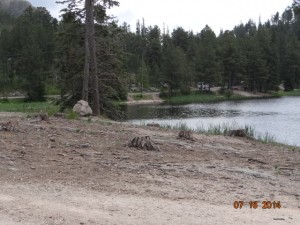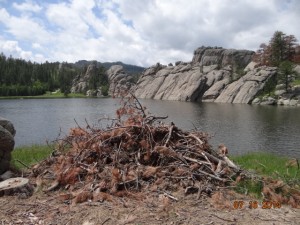The last few days I have reflected on my experience in the Black Hills. I visited one other time, 42 years ago. We drove across the upper Midwest, through Iowa. The Badlands and Mt. Rushmore were my first experiences of the west. The trip marks the first time that the western mountains and back country became my element. I have many visual impressions in my memory banks, such as hikes and stunning terrain, but few small details remain, such as where we camped. As I explored this time I had a few “déjà vu” moments, for example, coming around a curve and seeing a building or valley setting that I saw back then.
As I wander through this time I think about what has changed since 1972. People now walk around the Black Hills taking photos with camera phones. Bike riders wear lots of spandex and aerodynamic helmets. People drink out of disposable water bottles. The number of attractions has increased dramatically: I passed by one of everything here, including a wax museum, chuck wagon super show, and a presidential museum. Most notable is the addition of the Crazy Horse Memorial, a rock carving of the Indian Chief not far from Mt. Rushmore. The work on Crazy Horse began in 1948 but I don’t remember it being open to the public in the 1970s. We would have stopped, being “into” Indian culture and history like all idealistic and mobile Midwesterners who went west. This time, I am amused by the presence of a zip line attraction, which is now popular in tourist areas. A new generation of adventurers pays to hang on a line and zip through a forest—an interesting, sporting adaptation of an old method of transportation across rivers in China and elsewhere.
Spandex, cell phones, water bottles, and endless attractions are an interesting contrast to my memories of a Polaroid camera, patched up jeans, and flannel shirts. I don’t ever remember taking water with me. Did we live with constant dehydration back then? No matter, these details seem trivial compared to the devastating beetle kill in the forests. I estimate that half of the pines I passed by and hiked through in 1972 are dead due to the beetle kill. I have seen this many times in the western forests that I consider my home now, but I never get used to the shock of the eerie, altered terrain. The Pine Bark Beetle infestation was first noted in 1998. The studies I read seem inconclusive about whether the problem is natural selection, a warming climate or a combination of evolving forest ecosystems gone wrong because of climate change. Most alarming is a recent study by the University of Wisconsin-Madison, which says,
“With temperatures climbing from climate change, the mountain pine beetle is now moving to higher elevations on mountain slopes and is a ‘rising threat’ to the White Bark Pine, which is found mainly in the Rocky Mountains, coast range of B.C. and the northern U.S. Over most of the Interior, extreme winter weather (colder than minus 35 Celsius for at least several days or even weeks) historically killed most of the pine beetle population, limiting the duration of, and damage from, periodic epidemics. Such a widespread weather event has not occurred in the B.C. Interior since the winter of 1995/96.”
Back to the brown Black Hills:

Black Hills, SD
I learn in a government publication, “.. the Mountain Pine Beetle (MPB) is a native insect to the Black Hills. Traditionally MPB has existed in the Black Hills at endemic levels, with periodic outbreaks coinciding with favorable conditions. Since 1997, the current MPB epidemic has impacted parts of Black Hills, affecting more than 500,000 acres to date.”
So what is the response to this dramatic change, the current status of the forest, and the future? Officials classify the affect lands into three management zones, as follows:
- Resiliency Zone,
- Restraining Zone, and a
- Recovery Zone
The Resiliency Zone has the highest priority for treatment, which involves aggressive tree removal from small infestation patches. The Restraining Zone focuses control efforts primarily on harvesting infested trees in patches too large for individual/group treatment, mainly through timber sales. The Recovery Zone focuses on hazardous fuel reduction, wildfire protection, and short-term timber supply protection.
In Custer State Park, the affected lands were certainly all Recovery Zone, a nice term for all trees dead as a door nail. The fire mitigation effort was visible everywhere—downed trees taken away leaving stumps and large piles of branches and brush swept from the forest floor.

Stumps along the trail

Brush from tree felling piled up
So much devastation, waiting to ignite. Yet, wildfire is a normal part of the natural process at work in this ecosystem. We will continue to experience wildfires that threaten people and economies, but fire is a good thing in this case, scrubbing the forests clean and allowing dormant white fir seed to burst forth from their cones. And, when I look beyond the brush piles and stumps, I see other natural forces already in play. In one valley, I see a colony of perky young aspen trees and low green grasses growing over bare soil. Wildflowers thrive. There is no doubt that the ravaged forest will rejuvenate, with aspen, spruce and subalpine firs. One commentator stated. “the mountain pine beetle epidemic that killed more than six million acres of Lodgepole pine trees in Colorado is over and the ravaged forests have begun to rejuvenate. I suspect that after another 42 years, adventurers and tourists will be coming here for the fall color display by the Aspen trees. It’s not a bad payoff if you have time to wait. I do not, but my son and any children he has may come here one day and marvel at the healthy new forests and at Mother Nature’s resiliency.
As I wander through the Black Hills this time, I also think about what has not changed: the rock formations, winding roads, pine-scented air. Mountain Bluebirds still call this unique landscape home.
Squirrels chatter in the trees and create little midden hills of pine cone scales. In many ways I am still the same person, despite a lifetime of experience, growth, and maturity. And in many ways, people wander still with blinders on. For example, how many travelers through the Black Hills wonder about the beetle kill and if human greed and consumption are a cause, as they are with our current global warming? How many care enough about that Aspen forest of the future to take action at back at home? I fear that if humans don’t evolve, the future is a bit bleaker than the one I envisioned 42 years ago.


